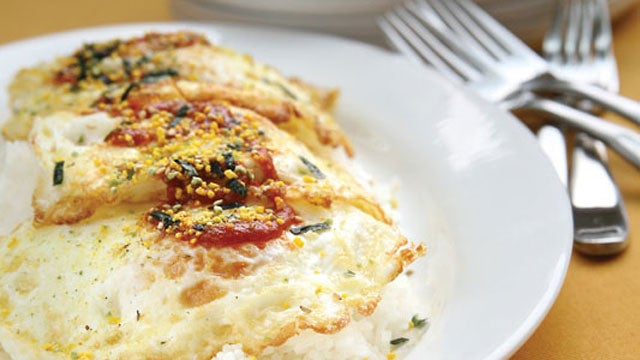What do you put in your body to own 683 miles of cycling over the course of seven days? The short answer is: a lot. But the type of food matters. During most races, riders are subjected to flavorless iceberg lettuce and gray buffet meat offered by hotels, but not at the Colorado Pro Cycling Challenge. Here, the chef, Biju Thomas, provides the event’s 150 riders with food before, during, and after events—and works with hotels to provide racers morning and evening options designed for both health and flavor.
Thomas guided us through one day of race recipes scheduled for the event’s time trial day in Vail on August 23. We took those recipes to Liz Applegate, a former pro triathlete and current director of sports nutrition at the University of California at Davis, to help us get a better look at how the food fuels the rider.
Breakfast: Oatmeal
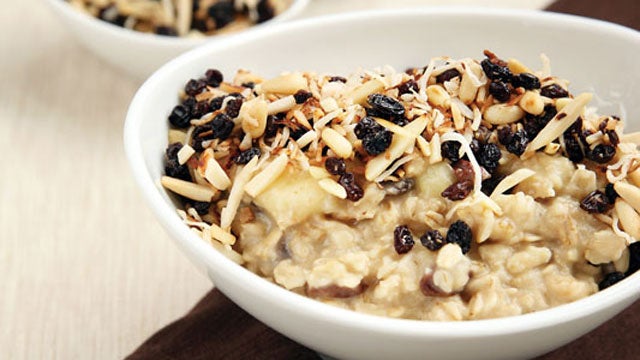
When you’re burning 6000-7000 calories a day, “breakfast is huge,” says Thomas. Oatmeal offers good caloric density, plus it’s a crowd pleaser for all the riders, no matter their country of origin. “If you offer something strange,” says nutritionist Applegate, “that starts to play games with athletes’ minds and stomach.” Oats are also a good source of complex carbohydrates, which, when converted to glucose, gradually release into the bloodstream.
“Being made with water, it’s a hydrating breakfast,” says Applegate. Even the banana helps. “You don’t think about it, but we get one fifth of our daily fluids from fruits and veggies.”
Servings: 2
Time: 10–15 minutes
Ingredients:
1 cup water
Dash of salt
1 cup “old-fashioned” rolled oats
1–2 cups milk, depending on desired thickness
1 tablespoon brown sugar
1 tablespoon molasses
1 banana, chopped
¼ cup raisins
In a medium saucepan, bring the water and salt to a low boil. Add oats and cook, stirring frequently, about 5 minutes.
Add milk and brown sugar, and return the mixture to a low boil. Add molasses, banana, and raisins, continuing to stir until oatmeal reaches desired thickness. Remove pan from heat. Let rest for 10–15 minutes if you have the time.
Finish with a sprinkle of ground cinnamon and a splash of milk.
Tip: Use any kind of milk—dairy, soy, almond. Start with 1 cup and add more to achieve your desired consistency.
This recipe republished with permission of VeloPress.
Pre-Race Snack: Rice & Eggs
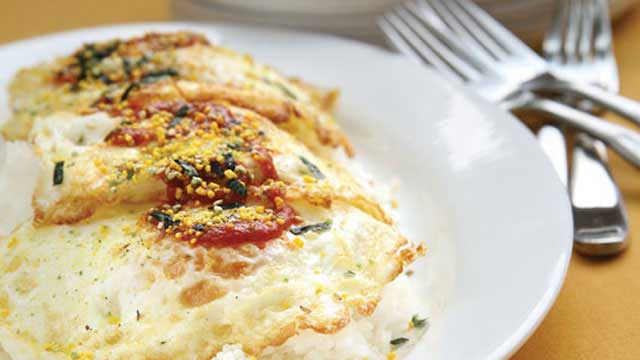
“We want the rice sticky because we want it dense,” says Thomas. “Per bite, you get a quarter more—if not double—the calories of other kinds of rice of the same volume.” The runny egg also provides protein and a little fat. For a runner, that much protein right before a race might not be advisable, but because cyclists operate for so long at such high intensities, there’s research that the protein might help with fatigue, while also offering small amounts of extra fuel.
“Notice that there’s a lot of sodium—more than half our daily allotment—but the cyclist needs this,” says Applegate, who points out that new research has suggested getting salt prior to a race might prompt cyclists to hydrate better. Pro athletes can exceed normal daily values because they lose so much salt in sweat. 42,000 feet of climbing and descents will do that to you.
Servings: 2
Time: 5 minutes
Ingredients:
4 cups cooked white rice
4 eggs
1 teaspoon salt
Optional Additions:
Sriracha sauce
liquid amino acids or low-sodium soy sauce
Japanese dry seasoning mix
toasted sesame seeds
Add a splash of water to the cooked rice and warm in a sauté pan over medium-high heat. Cook the eggs however you like: sunny-side up, over easy, or scrambled. In a large bowl, combine the rice and eggs and add the salt, along with your favorite seasoning.
Tip: If you are watching your sodium intake, cut the salt to ½ teaspoon and use liquid amino acids or low-sodium soy sauce instead of soy sauce or Japanese seasoning.
This recipe republished with permission of VeloPress.
��
Race Food: Bacon and Maple Rice Cakes
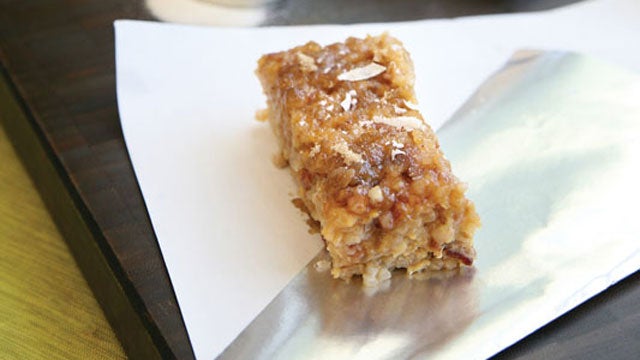
Out of a mobile food-truck, Thomas offers the racers a selection of rice cakes they can consume during the ride. The sweet and salty bacon and maple syrup variety tends to be the rider favorite. They’re preferable to some pre-packaged bars, says Thomas, because they pack in more liquid, and they don’t require a swig of water to swallow.
The bacon may also help riders feel strong for longer. According to some exercise physiologists, “fatigue may be mediated in the brain, not the muscles,” says Applegate. “Some protein during a long intense ride may ward off fatigue by altering neurotransmitter levels.”
Servings: 10
Time: 10 Minutes
Ingredients:
2 cups uncooked calrose or other medium-grain “sticky” rice
3 cups water
8 ounces bacon
4 eggs
2 tablespoons liquid amino acids or low-sodium soy sauce
brown sugar
salt and grated parmesan (optional)
1. Combine rice and water in a rice cooker.
2. While rice is cooking, chop up bacon before frying, then fry in a medium sauté pan. When crispy, drain off fat and soak up excess fat with paper towels.
3. Beat the eggs in a small bowl and then scramble on high heat in the sauté pan. Don’t worry about overcooking the eggs as they’ll break up easily when mixed with the rice.
4. In a large bowl or in the rice cooker bowl, combine the cooked rice, bacon, and scrambled eggs. Add liquid amino acids or soy sauce and sugar to taste. After mixing, press into an 8- or 9-inch square baking pan to about 1½-inch thickness. Top with more brown sugar, salt to taste, and grated parmesan, if desired.
Cut and wrap individual cakes. Makes about 10 rice cakes.
Time: We always use calrose rice, a strain of medium-grain rice common in Asian cooking. This variety cooks fast (in 20 minutes or less), retains a nutty flavor, and is just sticky enough to hold our cakes together. If you can’t find it, use another medium-grain rice or any kind marked “sushi rice.”
This recipe republished with permission of VeloPress.
Post-Race Snack: Sweet Potato Egg Burrito
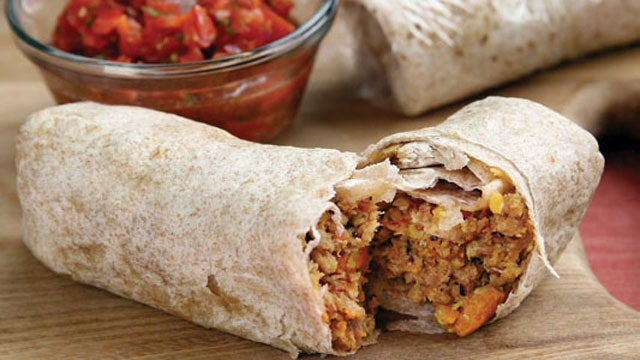
The post-race snack is all about bouncing back quickly. After hours of spending glycogen and expelling sodium, Thomas says, “They’re typically craving something salty and sweet.” His burrito offers both, restoring glycogen stores and replacing shredded salt.
Applegate points out that racers will accrue lots microscopic protein tears in their muscles after days of hard racing. That’s why this recovery meal’s protein content is so important. Turkey and eggs are a high quality source, supplying branch chain amino acids to the body, which are important for rapidly repairing tired muscles. The antioxidants present in beans also aid in muscle recovery.
Servings: 6
Time: 20 Minutes
Ingredients:
1 cup cooked sweet potato, packed
8 ounces lean ground turkey
6 eggs, lightly beaten
1 tablespoon liquid amino acids
½ tablespoon brown sugar
½ cup shredded cheddar cheese
6 large (10-inch) whole wheat tortillas, warmed
Optional Additions:
6 tablespoons prepared salsa
2 cups cooked red kidney or adzuki beans, drained and rinsed
2 teaspoons taco spice
chopped cilantro or chives
Mash the cooked sweet potato (peeled or not; your choice). Bring a lightly oiled sauté pan to medium-high heat. Add the ground turkey and brown. Add mashed sweet potato and eggs, plus optional additions, if using; stir until the eggs have set to a soft scramble. Remove from heat. Add liquid amino acids, brown sugar, and salt and pepper to taste.
Divide mixture among warmed tortillas. Top with shredded cheese and roll up as burritos, being sure to tuck in both short edges before folding the long ones (this will keep the contents from spilling out). Wrap in plastic and refrigerate or freeze.
This recipe republished with permission of VeloPress.
Dinner: Salmon, Brown Rice, Chopped Vegetable Salad
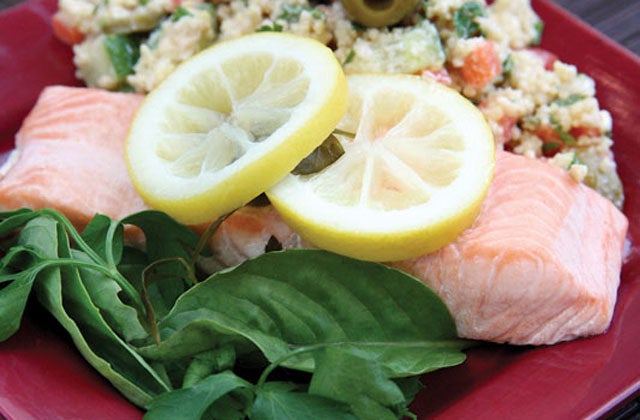
At most races, salmon is a delicacy, but Thomas knows it’s important not only for health, but for the psyche. Namely, it’s not a slab of colorless hotel meat. Salmon is also an excellent provider of omega-3 fats—the kind we need, but can’t brew on our own. These fats help curb inflammation and keep our heart and blood vessels in good shape.
After avoiding it for most of the day, Thomas finally offers riders lots of insoluble fiber via whole grains and veggies. “Everything is about getting the riders to sleep well and getting their stomach to empty in the morning,” says Thomas. The insoluble fiber offered at dinner helps food move through the digestive system over night, when racing isn’t imminent.
The sides offer all sorts of other benefits, too. The antioxidants in grains and greens soothe agitated muscles, says Applegate, and kale, tomatoes, and other colorful veggies contain vitamin K, beta-carotene and other antioxidants, which promote bone health, cell growth, along with calming muscle inflammation. It’s everything they need at the end of a tough day—and to prepare for the next…and the next.
Servings: 2
Time: 10 Minutes
Ingredients:
��½ of a lemon, sliced
A few sprigs of fresh herbs: parsley, thyme, basil, cilantro
2 small salmon fillets (3–4 ounces each)
In a wide pan bring to a gentle boil 1 inch of water. Add the lemon slices and herb sprigs.
Place salmon, skin side down, into the poaching liquid. It will begin to turn opaque in 3–4 minutes. Turn over; continue cooking until flesh is evenly pink. Remove the skin (it should pull off easily) and set filets on paper towels to drain.
Add salt, pepper, and lemon juice to taste, along with a touch of butter or olive oil.
This recipe republished with permission of VeloPress.


